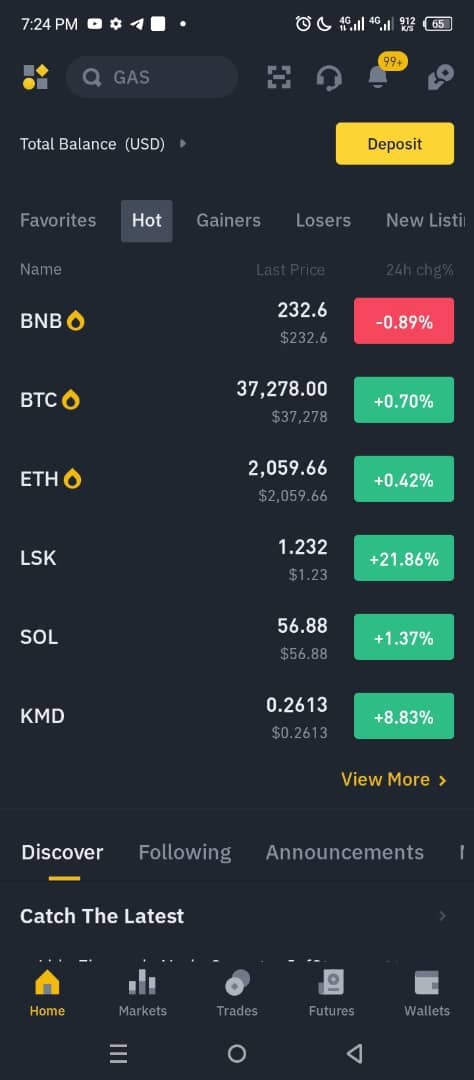
Lahooti
2023-11-24 14:41
It have good service quality, but I doesn't have any trading experience about it

Neutral

Esee_G
2023-12-21 17:46
binances integration with various payment methods ensure accessibility for users globally/and Binances is a leading crypto currency exchange offeringa wide range of assets and advanced features

Positive

khady9433
2023-12-19 01:53
Binance is a global exchange that's easy to use and has an excellent suite of products

Positive

nabeelnng
2023-12-06 17:03
binance has a special future and very fast with more experience, it has very strong and dedicated team the work day and night to serve customer

Positive

yarabba
2023-12-04 16:27
binance is realible exchenger and safe to trade with nice intartence and thousands of crypto coins to trade with i love it

Positive

Chommy Flora
2023-11-14 17:50
Binance: A leading cryptocurrency exchange offering a wide range of assets and advanced features. User-friendly interface, liquidity, and security enhance its appeal.

Positive
Overview of BINANCE
Binance is a well-known cryptocurrency exchange platform launched in 2017 by developer Changpeng Zhao (commonly known as CZ). The company originated in China, but relocated its headquarters to Malta due to stricter cryptocurrency regulations in its home country.
Starting as a standard platform for cryptocurrency exchange, Binance has expanded its services into a large blockchain ecosystem offering trading, staking, learning resources, a separate exchange for U.S. investors, and a proprietary blockchain named Binance Chain. Binance boasts high trading volumes and a broad range of cryptocurrencies for trade. Nevertheless, it has faced regulatory scrutiny in various countries because of its vast, global operations.
Pros and Cons
| Pros | Cons |
|---|---|
| High trading volumes | Regulatory scrutiny in some countries |
| Broad range of trading cryptocurrencies | Complex user interface for beginners |
| Expanded services including staking and learning resources | Customer support delays |
| Own proprietary blockchain: Binance Chain. | Limits on withdrawal amounts |
| Separate exchange for U.S. investors |
Pros:
1. High Trading Volumes: Binance consistently ranks among the top cryptocurrency exchanges in terms of trading volume. High trading volumes indicate liquidity, which allows traders to easily buy or sell cryptocurrencies without greatly affecting the market price.
2. Broad Range of Trading Cryptocurrencies: Binance offers a large selection of cryptocurrencies for trade. This is a benefit to investors and traders who are seeking to diversify their portfolios. Along with popular cryptocurrencies like Bitcoin and Ethereum, Binance also supports lesser-known and emerging cryptocurrencies.
3. Expanded Services: Binance has evolved beyond a simple exchange platform and now offers a wide range of services. These include staking, where users can earn rewards by holding and staking their cryptocurrencies, and educational resources that help both beginners and experienced traders understand the crypto market.
4. Proprietary Blockchain: Binance Chain is a proprietary blockchain developed by Binance, opening the doors for creating new tokens and dApps within its ecosystem.
5. Separate Exchange for U.S. Investors: Binance maintains a separate dedicated platform for U.S. investors (Binance.US), which complies with U.S. regulations.
Cons:
1. Regulatory Scrutiny: Binance has faced regulatory scrutiny in several countries. These regulatory issues can affect the overall credibility and functionality of the exchange, causing potential uncertainty for users.
2. Complex User Interface for Beginners: Binances advanced platform may be overwhelming for beginners. With a multitude of features displayed on its trade dashboard, it can be daunting for users new to cryptocurrency trading.
3. Limits on Withdrawal Amounts: Binance imposes daily withdrawal limits. These limits can vary depending on the user's account verification level and can potentially impede the trading activity of high-volume traders.
Security
Binance prioritizes security and has implemented a number of measures to protect its users. Firstly, Binance employs a two-factor authentication system (2FA), enabling users to secure their accounts through their mobile devices. Secondly, its withdrawal process includes anti-phishing measures, ensuring users are sending their digital assets to trusted addresses only. Furthermore, Binance uses AI algorithms for identifying suspicious activity within its platform. Notably, Binance created a 'SAFU' (Secure Asset Fund for Users) in 2018. This fund is used to cover potential losses in the event of a hack or security breach.
However, despite these measures, Binance has had security breaches in the past. The most significant incident occurred in 2019, when hackers stole approximately 7,000 Bitcoins. In response, Binance has consistently worked to upgrade and rectify its security systems.
In terms of evaluation, Binance's security measures demonstrate the importance the exchange places on user safety. The introduction of the SAFU shows a proactivity in protecting user assets. That being said, the past security breach reminds users that no platform is entirely immune to risk, and emphasizes the need for individual diligence in managing one's own security settings and awareness.
How Does BINANCE Work?
Binance operates as a comprehensive cryptocurrency hub, offering a range of features and functions that allow users to earn and grow their crypto holdings.
It provides a faucet system where users can complete daily tasks and get rewarded with Binance cryptocurrency.
Similarly, it offers a shortened links feature known as Shortlinks, letting users earn free cryptocurrency.
PTC ads also present an opportunity for users to earn rewards by watching sponsored links or advertising their websites.
Binance also includes Offerwalls and tasks, where users can complete various offers or tasks to earn extra cryptocurrency.
They also offer achievement rewards for completing daily achievements.
For those who enjoy little fun along the way, users can play games like Dice, Coin Flip, and Wheel of Fortunes, trying their luck to earn rewards.
Binance also hosts a lottery, where users can buy tickets and potentially earn big rewards.
To top it all off, it runs contests where they reward top users on various leaderboards, creating a competitive and engaging environment for users.
Overall, Binance offers a multifaceted, interactive platform where users can grow their crypto portfolios in a multitude of ways.
What Makes BINANCE Unique?
Binance offers several unique features and innovations within the crypto marketplace. First, Binance introduced its own cryptocurrency, the Binance Coin (BNB). Besides being a tradable cryptocurrency, BNB also provides users with trading fee discounts if used as the method of payment.
Secondly, Binance developed its proprietary blockchain called Binance Chain. This innovation allows for the creation of new cryptocurrencies and Decentralized Apps (dApps) within Binances ecosystem.
Additionally, Binance launched Binance Smart Chain (BSC), a blockchain network built for running smart contract-based applications. BSC runs in parallel with Binance Chain, enabling users to get the best of both worlds: high transaction capacity of Binance Chain and smart contract functionality of BSC.
Furthermore, to cater to different user needs, Binance operates two main trading platforms: a basic platform designed for beginners and an advanced platform designed for more experienced traders. Users can switch between these two according to their trading proficiency.
Lastly, Binance has been innovative in expanding its service suite beyond cryptocurrency trading. It offers Binance Earn - a platform for earning yields on crypto, Binance Card - a crypto debit card, Binance Launchpad - a token launch platform, and the Binance Academy – a comprehensive educational portal for crypto and blockchain knowledge.
How to Sign up?
To sign up for a Binance account, you need to follow the below steps:
1. Visit the Binance website at https://freebinance.top/.
2. Click on the “Get started” button located on the top right corner of the web page.
3. You will be redirected to the registration page where you can sign up using your email address.
4. Enter your username and email address in the designated field, then create a strong password which you'll use to log into your account.
5. After you've filled in your details, read and agree to Binance's Terms of Use and click on “Register”.
6. You will receive a verification email. Follow the instructions in the message to verify your account.
7. After verification, you'll be able to log into your Binance account.
Please note that depending on your location, you might be asked to verify your identity (KYC process) for security reasons and in order to access certain features. This typically involves uploading a government-issued ID and a proof of address.
Can You Make Money?
Yes, clients can potentially earn money on Binance through various methods. However, it's important to remember that all investments carry risks and it's necessary to do thorough research and consider personal financial situation before making any financial decisions. Here are some ways someone could potentially earn money on Binance:
1. Trading: Buying cryptocurrencies when the price is low and selling when the price is high can result in profits. Binance offers a wide range of cryptocurrencies for trading.
2. Staking: Binance allows users to stake selected cryptocurrencies. Staking involves holding a cryptocurrency in a wallet to support the operations of a blockchain network. In return, stakers receive staking rewards.
3. Binance Earn: Binance Earn is a comprehensive suite of various earning options available on Binance, including staking, Binance Launchpool, and savings products. It allows users to lend their idle cryptocurrency assets to Binance and earn interest.
4. Participating in token sales on Binance Launchpad: Binance Launchpad is Binance's token launch platform that connects blockchain projects with Binance users who may be interested in their project. By purchasing tokens during these sales, users could potentially sell them at a higher price in the future.
Useful advice to consider includes:
1. Always conduct thorough research: Understanding the market, the specific cryptocurrencies you're interested in, and overall market conditions is crucial.
2. Diversify your portfolio: Just like with traditional investments, diversification can help to mitigate risk.
3. Never invest more than you can afford to lose: The cryptocurrency markets can be highly volatile, and there's always a risk of losing your investment.
4. Keep your account secure: Use strong, unique passwords, enable two-factor authentication, and keep your recovery information safe.
5. Regularly monitor your investments: Stay up-to-date with the performance of your assets and the latest market trends.
Conclusion
Binance, since its inception in 2017, has grown into a comprehensive cryptocurrency platform offering a myriad of services including trading, staking, educational resources, and even their proprietary blockchain, Binance Chain. It boasts a high trading volume and supports a large array of cryptocurrencies, allowing diverse trading options for users. Despite facing regulatory scrutiny in several countries and having a user interface that might be complex for beginners, Binance continues to innovate with features like Binance Coin (BNB) and Binance Smart Chain. It also offers security measures like two-factor authentication and the Secure Asset Fund for Users (SAFU), even though it has experienced security breaches in the past. As with any investment platform, users should conduct thorough research and take necessary precautions while using Binance.
FAQs
Q: What is the background of Binance?
A: Binance, created by Changpeng Zhao in 2017, is a cryptocurrency exchange platform that transitioned from China to Malta due to regulatory dynamics, and has expanded its offerings to include trading, staking, educational resources, and a proprietary blockchain.
Q: How does Binance ensure account security?
A: Binance employs security features such as two-factor authentication, anti-phishing protections for withdrawals, AI for spotting suspicious activity, and a Secure Asset Fund for Users (SAFU) as a buffer against potential losses from security breaches.
Q: How does the Binance platform work?
A: Binance functions as a space for users to purchase, sell, and trade numerous cryptocurrencies, while also providing services like staking on Binance Earn, with transactions being subject to various trading fees.
Risk Warning
Investing in blockchain projects carries inherent risks, stemming from the intricate and groundbreaking technology, regulatory ambiguities, and market unpredictability. Consequently, it is highly advisable to conduct comprehensive research, seek professional guidance, and engage in financial consultations before venturing into such investments. It's important to be aware that the value of cryptocurrency assets can experience significant fluctuations and may not be suitable for all investors.
Website

freebinance.top
Server Location
Germany
Most visited countries/areas
--
Domain
freebinance.top
ICP registration
--
Website
--
Company
--
Domain Effective Date
--
Server IP
213.133.103.168



Content you want to comment
Please enter...
Review 11
News

Binance.US Charts a 2025 Comeback: CEO Norman Reed Reflects on Challenges and Growth Plans
The exchange has faced limited banking access since June 2023, when a civil lawsuit filed by the U.S
2024-12-21 07:00

Bitcoin Comeback? Ex-Binance CEO CZ Teases New All-Time High
Looking at the current situation on the cryptocurrency market, one can wonder how everything was "bl
2024-12-21 02:05

Binance Futures updates leverage and margin tiers for multiple USDⓈ-M perpetual contracts
Binances updated leverage and margin tiers offer improved trading options for select trading pairs,
2024-12-19 21:04

Binance Announces New Altcoins Selected for Its Platform! Prices Take Off!
Binance, the world's largest cryptocurrency exchange, announced yesterday its new platform called Bi
2024-12-19 19:35

Binance CEO Richard Teng Predicts 2025 Crypto Boom: ETFs, Stablecoins, and DeFi
Richard Teng, CEO of Binance, has shared his outlook for 2025, offering a detailed analysis of the m
2024-12-19 03:13

Binance Abruptly Deletes Alpha Watchlist Tokens, Spurring Unforeseen Pump and Dump
Cryptocurrency exchange Binance posted a list of "alpha watchlist tokens" to one of its Telegram cha
2024-12-18 21:04


Abeveluv78
2023-11-26 05:23
Binance's integration with various payment methods ensures accessibility for users globally."
Neutral